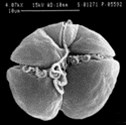The week of July 21, a new modeling tool based on models funded by the NCCOS Ecology and Oceanography of Harmful Algal Bloom ( ECOHAB ) and Monitoring and Event Response for Harmful Algal Blooms ( MERHAB ) Programs predicted and detected a Red Tide harmful algal bloom (HAB) off the West Coast of Florida. The University of South Florida's (USF) Collaboration for Prediction of Red Tides provided optical images and model forecasts to the Florida Fish and Wildlife Conservation Commission (FWC), who then collected fish and water samples from six locations offshore of Hernando County and confirmed a bloom of the Florida Red Tide,Karenia brevis,in time for FWC to issue a public notice on July 25, 2014.

The Florida Red Tide dinoflagellate, Karenia brevis. Credit: Florida Fish and Wildlife Conservation Commission
Information provided to FWC by USF showed a bloom approximately 80 miles long and 50 miles wide occurring 40 to 90 miles offshore between Dixie, Hernando, and Pasco counties.Researchers found K. brevison both the surface and at depths up to 20 meters, and the bloom caused an ongoing fish kill in the northeast Gulf of Mexico.
FWC's Fish Kill Hotline received reports of thousands of unconfirmed dead and moribund benthic reef fish including various snapper and grouper species, hogfish, grunts, crabs, sea turtles, flounder, bull sharks, lionfish, baitfish, eel, sea snakes, lizardfish, filefish, octopus, and triggerfish. The potential impact of the bloom on endangered sea turtles, the focus of another ECOHAB project, is especially of concern.
NCCOS HAB research is supporting the ongoing development and improvement of federal-state-academic HAB forecasting for the eastern Gulf of Mexico.
For more information, contact Quay.Dortch@noaa.gov.
 Official websites use .gov
A .gov website belongs to an official government organization in the United States.
Official websites use .gov
A .gov website belongs to an official government organization in the United States. Secure .gov websites use HTTPS
A lock or https:// means you’ve safely connected to the .gov website. Share sensitive information only on official, secure websites.
Secure .gov websites use HTTPS
A lock or https:// means you’ve safely connected to the .gov website. Share sensitive information only on official, secure websites.